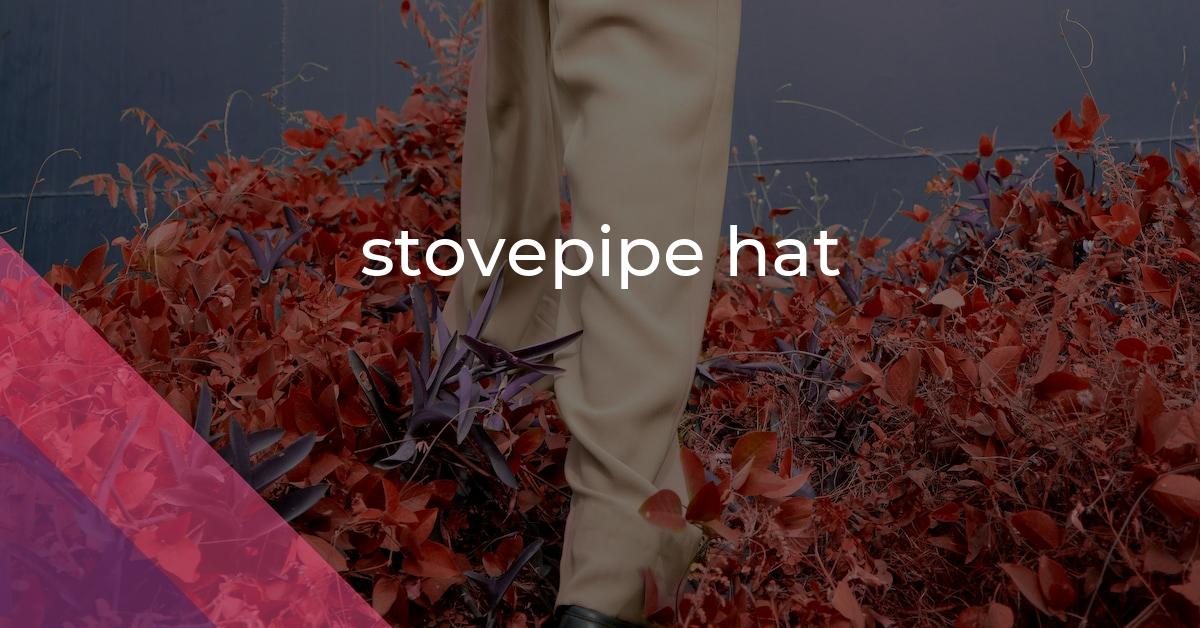stovepipe hat: Idiom Meaning and Origin
What does ‘stovepipe hat’ mean?
A stovepipe hat is a tall, cylindrical hat with a narrow brim, typically made of a stiff material like felt or silk. As an idiom, it refers to a person who holds a high position or has a lot of authority, especially in a formal or official setting.

Idiom Explorer
The idiom "wear too many hats" means to take on multiple roles or responsibilities, often to an excessive or overwhelming extent, resulting in a lack of focus or effectiveness. It suggests a person taking on more tasks than they can effectively handle.
The idiom "tall in the saddle" means being in a position of power, confidence, or authority. It refers to someone who is self-assured and in control, especially in challenging or difficult situations.
The idiomatic expression "talk through one's hat" means to say something without knowledge or authority, often resulting in falsehoods or nonsense.
"Stuck up" is an idiom used to describe someone who is arrogant, snobbish, or thinks they are superior to others. It implies a sense of haughtiness and a lack of humility.
The idiom "stovepipe" refers to a situation or system that operates in isolation, lacking interaction with other parts, resulting in limited information flow and inefficiency.
The idiomatic expression "smoke like a chimney" means to smoke a lot or excessively, often referring to the act of smoking cigarettes or pipes. It implies a person who smokes constantly or has a heavy smoking habit.
The idiom "set of pipes" refers to a person's voice, specifically indicating their ability to sing or speak loudly and with a pleasant tone. It highlights the strength and quality of someone's vocal abilities.
The idiom "rain pitchforks" means to rain very heavily or intensely. It is often used to describe a downpour of rain or a severe storm.
The idiom "put that in your pipe and smoke it" is used to dismiss someone's argument or opinion, implying that they should accept or deal with a particular fact or situation that may not be in their favor.
The idiom "put a hat on a hat" means to make a situation or an idea unnecessarily complicated or redundant by adding extra layers or elements.
Fascinating Origins
A stovepipe hat is a type of hat that was popular in the 19th century in the United States. It is tall and cylindrical with a flat top. The origin of the term "stovepipe hat" is unclear, but it is believed to have come from the hat's resemblance to a stovepipe, which is a pipe used for ventilation.
The stovepipe hat gained popularity in the mid-19th century and was worn by men of different social classes. It became closely associated with Abraham Lincoln, the 16th President of the United States. Lincoln was often seen wearing a stovepipe hat in photographs and public appearances. This association has made the hat iconic and historically significant.
The stovepipe hat's popularity can be attributed to its tall and elegant shape, which conveyed a sense of height and authority. The hat was typically made of luxurious materials such as beaver or silk, which added to its prestigious appeal.
The stovepipe hat is not only associated with Abraham Lincoln but also with other figures and characters in popular culture. It is frequently depicted in portrayals of fictional characters from the Victorian era, like the Mad Hatter from Lewis Carroll's "Alice's Adventures in Wonderland."
Today, the stovepipe hat is considered a classic and iconic fashion accessory, although its popularity has diminished over time. It is still worn on certain formal and ceremonial occasions, such as weddings or historical reenactments. The hat continues to hold historical significance in American culture.
The precise origin and meaning of the term "stovepipe hat" are debated among linguists and historians. While several theories exist, none can be definitively proven. The reasons for its popularity in the 19th century are also unclear due to limited historical records on individual fashion preferences at the time.
Despite these uncertainties, the stovepipe hat has left a lasting impact on American culture and fashion. Its association with Abraham Lincoln and its distinctive appearance have cemented its status as a symbol of authority, refinement, and historical significance. The enduring interest in and recognition of the stovepipe hat exemplify the lasting power of iconic symbols that transcend time and cultural shifts.
The idiom "old hat" is related to the stovepipe hat. It means something that is considered outdated or no longer interesting or relevant. While the stovepipe hat was once fashionable and popular, it is now considered more of a historical fashion statement than a contemporary trend. It has become a symbol of a bygone era and is not commonly seen in modern fashion.
The idiom "piping hot" is also related to the stovepipe hat. It means something that is extremely hot, like the steam that rises from a pipe or stove. In this context, the idiom can be used to describe the popularity and attention that the stovepipe hat once enjoyed. It was a hot fashion trend during the 19th century, capturing the attention of men from all social classes. The hat's distinctive shape and stylish materials made it a standout accessory.
The idiom "talk through one's hat" is another idiom related to the stovepipe hat. It means to speak without knowledge or authority, often making false or exaggerated claims. While the stovepipe hat is associated with authority and prestige, the idiom suggests that one should not assume expertise based solely on appearance. Just because someone wears a stovepipe hat does not necessarily mean they possess wisdom or knowledge. It serves as a reminder to be cautious in accepting information at face value and to seek reliable sources.
Example usage
Examples of how the idiom stovepipe hat can be used in a sentence:
- He wore a black stovepipe hat that reminded everyone of Abraham Lincoln.
- During the historical play, the actor donned a tall stovepipe hat to portray a character from the 18th century.
- The magician pulled a live rabbit out of his stovepipe hat, leaving the audience in awe.
More "Clothing" idioms



